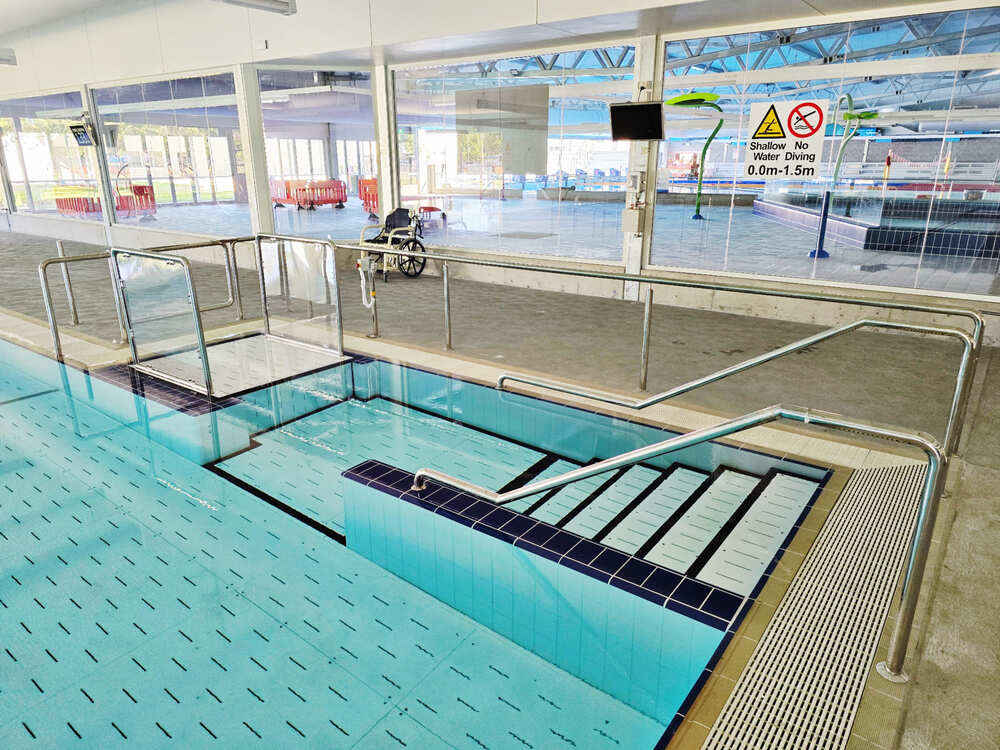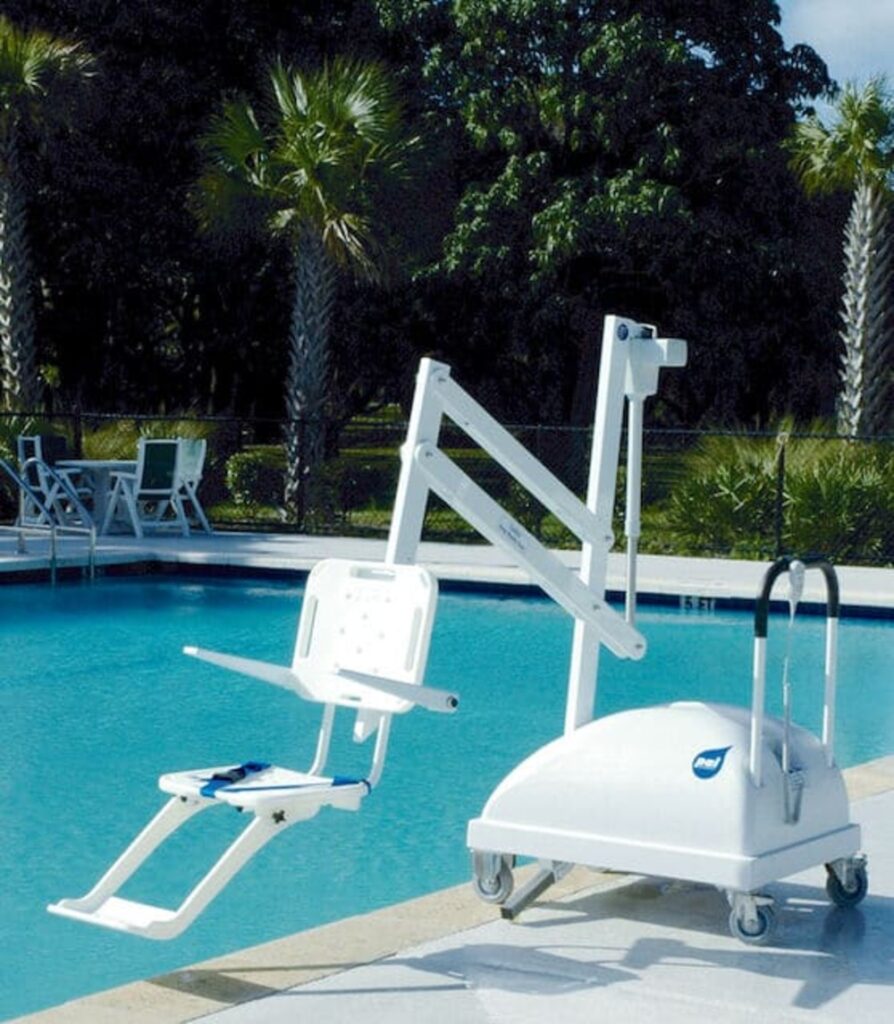Creating accessible swimming facilities requires mastering the specific requirements that transform standard pools into ADA compliant pools. These regulations, established under the Americans with Disabilities Act, mandate accessibility features that ensure equal access to aquatic recreation for individuals with disabilities.
Professional pool contractors face growing demand for accessible design solutions across commercial, hospitality, and institutional markets. The ADA Standards for Accessible Design provide detailed specifications that affect project planning, equipment selection, and construction methods. Understanding these requirements positions you to capture expanding market opportunities while delivering legally compliant facilities.
Note: ADA regulations are only applicable in the United States, so other countries have different laws that must be followed in order to build an inclusive and accessible swimming pool. In Spain, for example, the Universal Accessibility Law (Law 15/2003) governs accessibility for people with disabilities. This law establishes general requirements to ensure accessibility in various spaces, including swimming pools. It is important to note that regulations may vary from country to country, so it is advisable to consult the specific legislation of each region to ensure compliance.
This technical guide provides the comprehensive knowledge you need to design, construct, and modify ADA compliant pools that meet regulatory standards while exceeding client expectations for inclusive design.
Dive deeper with the eBook
Regulatory Framework and Professional Requirements
ADA Compliance Scope for Pool Facilities
All public accommodations must provide ADA compliant pools when aquatic facilities are offered to guests, members, or the general public. This requirement encompasses hotels, health clubs, recreational facilities, educational institutions, and healthcare centers. Commercial facilities serving employees or tenants also fall under ADA jurisdiction when pools exceed specified usage thresholds.
The law distinguishes between public and private pool facilities based on access and usage patterns. Private residential pools remain exempt unless they serve commercial functions or provide public access. However, demographic trends toward aging populations create market opportunities for contractors specializing in accessible residential design solutions.
Compliance Standards and Professional Accountability
ADA enforcement has intensified across the hospitality and fitness industries, with significant financial penalties for non-compliant facilities. Recent settlements have exceeded millions of dollars, making proactive compliance a critical business investment. Professional contractors share liability exposure when accessibility features are inadequately designed or improperly installed.
Documentation requirements extend throughout the project lifecycle, from initial design specifications through final commissioning and ongoing maintenance protocols. Comprehensive project records protect both contractors and clients from future accessibility-related claims.

Technical Requirements for Pool Accessibility
Access Point Configuration Standards
ADA compliant pools must incorporate specific entry and exit configurations based on facility size and perimeter dimensions. Pools with perimeters under 300 linear feet require one accessible entry point, while larger facilities need two accessible means of entry. These requirements ensure adequate access regardless of pool configuration or user volume.
Approved entry methods include pool lifts, sloped entries, transfer walls, transfer systems, and accessible stairs with compliant handrails. Each option addresses different user needs and site constraints. Pool lifts accommodate wheelchair users requiring assisted transfers, while sloped entries provide independent access for individuals with varying mobility levels.
Entry point locations must consider water depth limitations, with maximum depths of 48 inches at access areas. Deck clearances require 36-inch minimum widths extending 48 inches from pool edges, providing adequate maneuvering space for wheelchairs and mobility devices. These spatial requirements influence fundamental pool design parameters from project inception.
Equipment Specifications and Performance Standards
Pool lift systems must meet rigorous operational criteria to qualify for ADA compliant pools installations. Weight capacity requirements specify 300-pound minimum lifting capability, with seat heights between 16 and 19 inches above deck level. Control systems must operate with minimal force requirements and accommodate users with limited hand function.
Sloped entry specifications mandate maximum gradients of 1:20 (5 percent) along entry routes and 1:12 (8.33 percent) within water areas. Handrail systems are required when slopes exceed 1:20, with specific dimensional and structural requirements. Entry depths must range between 24 and 30 inches below normal water level for safe user access.
Transfer wall and platform systems require heights between 16 and 19 inches with minimum 12-inch widths for stable wheelchair transfers. Grab bar installations must meet specific mounting heights, gripping surfaces, and structural load requirements. Professional installation ensures these components satisfy ADA performance standards and safety regulations.
Design Integration and Equipment Selection
Selecting Optimal Accessibility Solutions
Choosing appropriate access systems for ADA compliant pools requires evaluating multiple factors that influence both functionality and cost-effectiveness:
- Pool lifts – Offer maximum versatility for retrofit projects with minimal structural modifications required. Fixed installations provide permanent solutions with compact deck footprints, while portable units enable equipment sharing across multiple pool facilities.
- Sloped entries – Excel in new construction where design integration is paramount. These beach-style entries appeal to all users while providing seamless wheelchair access, though they require significant perimeter space allocation.
- Transfer walls and platforms – Work effectively in space-constrained environments or therapeutic settings. These solutions suit rehabilitation facilities where supervised transfers are routine practice.
- Accessible stairs – Provide cost-effective solutions for facilities serving users with moderate mobility limitations. Proper handrail configuration and tread dimensions ensure safe, independent access.
Architectural Integration Strategies
Contemporary ADA compliant pools seamlessly blend accessibility features with overall design aesthetics through careful planning and material coordination. Strategic equipment placement and color matching create cohesive visual presentations that enhance rather than compromise facility appearance. Professional design integration elevates accessibility from regulatory compliance to design excellence.
Circulation planning must accommodate accessibility equipment while maintaining adequate space for general pool users. Visual connections between access points and supervision areas ensure effective safety monitoring capabilities. Proper deck drainage around access equipment prevents water accumulation that could create safety hazards or equipment damage.
Illumination design requires enhanced lighting levels at access areas for safe equipment operation during all facility hours. Emergency communication systems should remain accessible from pool access points, providing safety resources for users requiring assistance. These comprehensive design considerations transform ADA compliant pools from basic compliance into exceptional user experiences.

Pool Modification and Retrofit Solutions
Existing Pool Assessment and Upgrade Planning
Converting existing pools into ADA compliant pools requires thorough facility evaluation and strategic modification planning to minimize operational disruption. Structural assessments determine deck and pool shell capacity for supporting accessibility equipment loads. Electrical system evaluations identify upgrade requirements for powered lift systems and enhanced lighting installations.
Available space typically determines feasible retrofit options, with pool lifts offering practical solutions for constrained sites. Deck modifications may be necessary to provide required clearances and equipment mounting surfaces. Professional analysis identifies cost-effective approaches while ensuring complete compliance with current accessibility standards.
Installation Management and Project Coordination
Successful retrofit implementations require careful scheduling to minimize pool closure periods and maintain facility operations. Pool lift installations typically require one to three days, depending on electrical work and structural modifications. Major modifications like sloped entry additions may necessitate extended closure periods for pool reconstruction.
Professional installation teams ensure compliance with manufacturer specifications and ADA requirements through proper equipment calibration and safety testing. Certified technicians provide comprehensive commissioning services including operational verification and staff training programs. Documentation of installation procedures and compliance verification protects facility owners from future liability concerns.
Market Opportunities and Business Advantages
Expanding Client Base Through Accessible Design
ADA compliant pools create significant market expansion opportunities by attracting diverse clientele and addressing underserved demographic segments. Accessible facilities appeal to aging populations, families with disabled members, and organizations prioritizing inclusive environments. This broader market reach translates into increased project volume and premium pricing opportunities.
Commercial properties featuring accessible pools command higher occupancy rates and rental premiums in competitive markets. Hotels marketing accessible amenities tap into the substantial disability travel market, estimated at over $13 billion annually. Fitness centers with ADA compliant pools attract therapeutic programs and specialized user groups that generate additional revenue streams.
Risk Mitigation and Professional Protection
Proactive ADA compliance protects clients from costly litigation and regulatory enforcement while enhancing professional reputation for thoroughness and technical expertise. Recent legal settlements in the hospitality and fitness industries demonstrate the financial risks of non-compliance. Professional documentation of compliance efforts provides strong legal defenses against accessibility-related claims.
Insurance carriers increasingly recognize ADA compliance as effective risk management, potentially reducing liability premiums for compliant facilities. Professional installation and maintenance of ADA compliant pools equipment demonstrates due diligence in safety and accessibility management. These documented efforts support favorable insurance underwriting and claims resolution.
Operational Excellence and Long-term Performance
Maintenance Programs for Accessibility Equipment
ADA compliant pools require specialized maintenance protocols to ensure accessibility equipment remains functional and safe throughout its operational life. Pool lifts need regular mechanical inspections, battery system maintenance, and operational testing according to manufacturer specifications. Handrails and structural components require periodic integrity assessments to maintain required load ratings.
Water chemistry management around accessibility equipment demands additional attention to prevent corrosion and mineral accumulation that could compromise performance. Stainless steel components need specific cleaning procedures to maintain both appearance and structural integrity. Preventive maintenance schedules address minor issues before they become major equipment failures.
Emergency Procedures and Safety Protocols
Facility operations must accommodate accessibility equipment and user needs through comprehensive emergency planning and safety procedures. Staff training includes proper equipment operation, emergency protocols, and appropriate assistance techniques for users with disabilities. Clear procedures ensure consistent service delivery while maintaining user independence and safety.
Emergency evacuation plans require special consideration for users who may need assistance exiting ADA compliant pools safely during power outages or equipment failures. Backup systems or manual operation capabilities ensure accessibility equipment remains functional during emergencies. Staff assignments and communication protocols ensure prompt assistance without compromising overall facility safety.
Professional Implementation Success
ADA compliant pools represent both regulatory obligations and significant business opportunities for professional contractors specializing in accessible design and construction. Understanding technical requirements, regulatory frameworks, and implementation strategies positions you as an accessibility expert capable of serving expanding markets while ensuring complete compliance with federal standards.
The transition toward inclusive design benefits all facility users while creating new revenue opportunities and market differentiation. Professional expertise in accessible pool construction commands premium pricing and builds long-term client relationships based on technical competency and regulatory knowledge. Investment in accessibility training and certification generates substantial returns through expanded market access and reduced liability exposure.
Successful ADA compliant pools projects require comprehensive planning, quality equipment selection, professional installation, and ongoing maintenance commitment. By embracing accessibility as a design philosophy rather than regulatory burden, you create facilities that serve entire communities while building sustainable specialization in today’s evolving construction marketplace.
